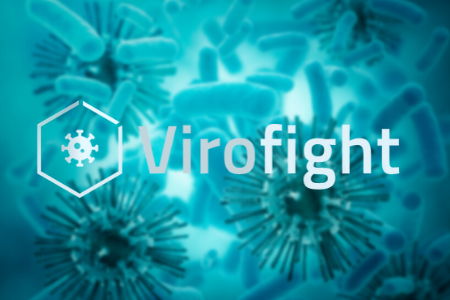
Need for a broad antiviral therapy
Viral infections are a threat to human health and affect millions of people every year. The VIROFIGHT consortium proposes a radically new approach to fight viral infections. Instead of targeting viral proteins by small molecules, as many current antivirals do, VIROFIGHT uses prefabricated nanoshells to trap and neutralize entire viruses. As a result, many different viruses in principle could be neutralized by the same shell platform without requiring detailed knowledge about the viruses. This novel approach could result in a broad antiviral drug which is urgently needed to mitigate severe viral infections and lower the risks of future viral outbreaks.
Construction of virus-trapping nanoshells
In this first year of VIROFIGHT, Hendrik Dietz and co-workers successfully demonstrated the feasibility of their antiviral technology. They constructed artificial nanoshells featuring inner cavities with diameters ranging from 40 nm to 280 nm, which is large enough to fit most human viruses. Consequently, a broad range of different viral pathogens could be targeted with the shells.
The design of nanoshells with similar sizes to viruses poses a fundamental nanoengineering challenge which was successfully tackled by Dietz and his team. The design concept relies on the structure of viruses and comprises triangles made out of DNA using the concept of DNA origami. The triangles have sizes a thousand times smaller than a human hair and feature a LEGO-like pattern on their edges, enabling multiple triangles to bind to each other. By varying the shape of the triangles and the LEGO-like pattern, shells with different sizes and user-defined openings can be constructed, which is needed for trapping viruses.
The nanoshells are highly modular structures and can easily be modified with different virus-binding molecules that are produced within the consortium. The shells fit up to 100 virus binders in their cavities, ensuring extremely strong binding to viruses. Moreover, the virus-binding molecules can easily be exchanged to target a variety of viruses. As a result, the shells could be quickly adapted to target different or new emerging viruses.
Neutralizing viruses
Since the VIROFIGHT consortium made good progress in the first year with establishing the shell platform technology, they already started with experiments to evaluate the virus-neutralization capacity of the shells. To this end, the consortium successfully tested the nanoshells on two different types of viruses. The shells not only trapped the viral particles but also prevented the infection of cells. The construction and validation of the virus-trapping nanoshells were recently published in the scientific journal Nature Materials[1].
While the nanoshells were successfully applied in cell culture, it remains unclear how they behave in living organisms. Therefore, the next crucial step in the development of the proposed generic antiviral platform is testing the virus-neutralizing shells in animals. Additionally, the consortium will further evolve its antiviral concept and test it on multiple different viruses.
VIROFIGHT is funded by the EU’s HORIZON 2020 programme and is supported for four years until May 2024. The results from the first year encourage that the creation of a novel broad antiviral technology is feasible.
|
[1] |
C. Sigl, E. M. Willner, W. Engelen, J. A. Kretzmann, K. Sachenbacher, A. Liedl, F. Kolbe, F. Wilsch, S. A. Aghvami, U. Protzer, M. F. Hagan, S. Fraden and H. Dietz, "Programmable icosahedral shell system for virus trapping," Nature Materials, 2021. |
- Reference
- 899619
- Project duration
- 1 Jun 2020 - 31 May 2024
- Project locations
- GermanyDenmarkFranceSlovenia
- Overall budget
- €3 880 940
- EU contribution
- €3 880 940100% of the overall budget
Stakeholders
Coordinators
TECHNISCHE UNIVERSITAET MUENCHEN
- Website
- http://www.tum.de
Participants
AARHUS UNIVERSITET
- Website
- http://www.au.dk
ARTTIC INNOVATION GMBH
ARTTIC
- Website
- http://www.arttic.fr
KEMIJSKI INSTITUT
- Website
- https://www.ki.si/